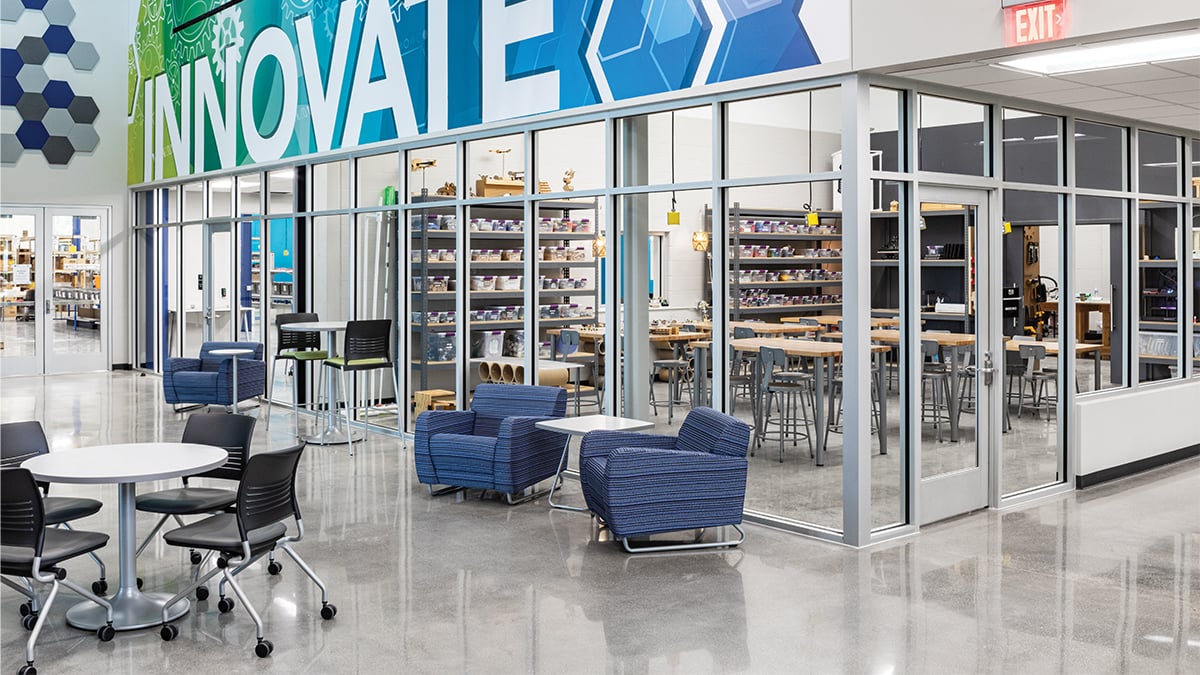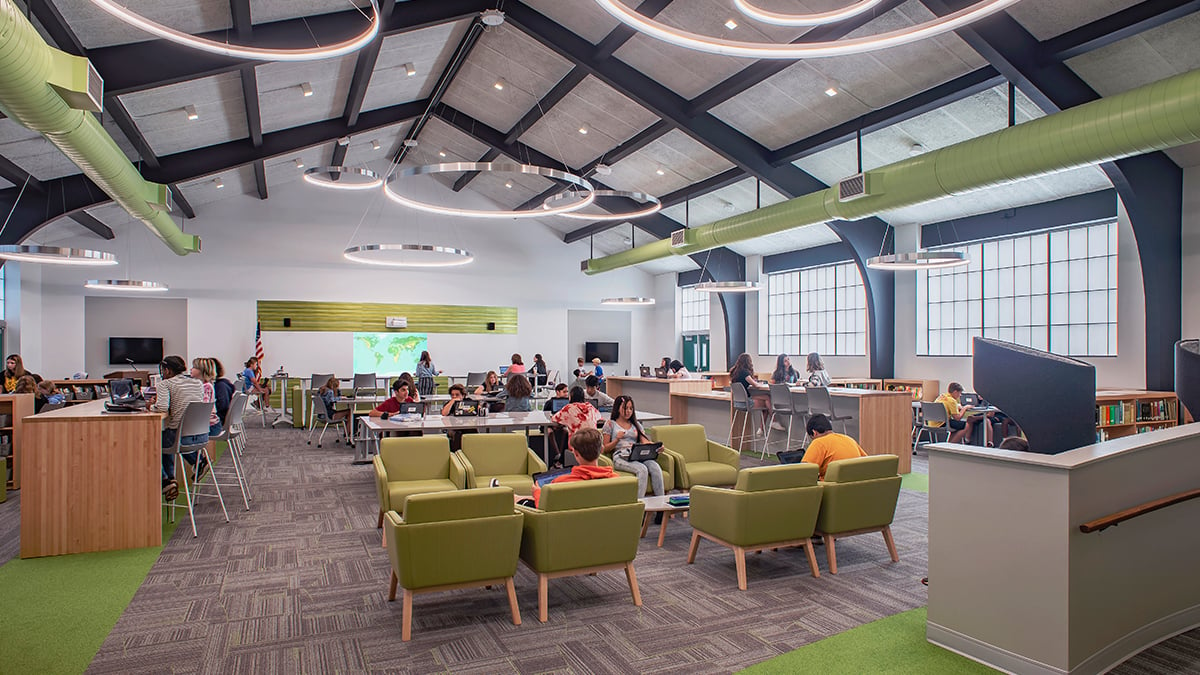- What's New
- Pricing & Purchasing
- Lead Times
- Literature & Samples
- Services & Warranties
- Careers
- Find a Rep
Design for College Libraries: 8 Ways to Prioritize Well-Being & Community

Discover key design strategies for college libraries that promote well-being, community, and adaptable, engaging third spaces.
In the first blog of our series on designing for the evolution of college libraries, we explored eight key shifts that are redefining the library experience, including the emphasis on adaptability and digital integration. From our intensive research and study of libraries across the country, we are excited to share more of what we have learned.
This second installment delves deeper into how well-being, community, and the “third space” concept are reshaping modern library design. From innovative furniture arrangements to biophilic design principles, we explore eight ways libraries can be reimagined to serve students, faculty, and the broader academic community.
1. Libraries as Third Spaces
College libraries today are evolving into dynamic third spaces, blurring the lines between formal academic settings and informal, community-oriented environments.
The term “third space” describes a place that exists between home and work or study, offering a welcoming and multifunctional environment. Libraries have increasingly become hubs where students can study, connect with peers, or even work remotely in a hybrid model.
This evolution is prompting architects, designers, and interior specifiers to think creatively about space utilization and how to foster a sense of belonging and collaboration. With multipurpose furniture that can be rearranged for various activities, libraries can cater to a wide range of user needs, from quiet study zones to active group collaboration areas.
2. Designing for Well-Being
The importance of well-being in educational settings has never been more pronounced than it is today.
In library design, well-being encompasses several elements: natural light, air quality, comfortable and ergonomic furniture, and access to restorative spaces. For instance, trauma-informed design principles are gaining traction, emphasizing equity and empathy.
This approach considers how choices for interior architecture and furniture can support students' mental and emotional health. Furniture that encourages ergonomic posture and offers flexibility, such as high-function task stools paired with standing-height tables, ensures that libraries accommodate diverse learning styles and promote physical comfort. Integrating natural light and biophilic design—extended through glass wall systems—and views of the outdoors further enhances the spatial experience, providing a calming and energizing atmosphere.
3. Posture & Place: Rethinking Seating Solutions
One of the most crucial aspects of library design is accommodating various postures and place types to support different activities. Students may require focused, individual spaces for research and writing, or they may need collaborative areas for group projects, spending different amounts of time in each posture.
Versatile furniture solutions, like privacy pods or nooks for quiet concentration or high-top tables for group brainstorming, offer choices that cater to these varied needs. Materials and seating types also play a vital role in promoting engagement and well-being. Student-focused seating solutions and modular lounge furniture such as our new Zeker line create a spectrum of postural support that enables students to transition seamlessly from solitary study to active collaboration.
4. Regeneration Spaces & “Chill Zones”
Libraries are no longer just spaces for academic productivity but also for regeneration and relaxation. Chill zones and meditation rooms are becoming integral to library design, providing students with a retreat from the demands of college life.
Incorporating elements reminiscent of coffee shops, such as soft seating and inviting ambiance, helps to create an environment conducive to both socializing and self-care. In some libraries, yoga classes or other wellness activities have become a part of the programming, further emphasizing the library’s role as a holistic support system for students.
5. Supporting Social-Emotional Learning (SEL)
Though SEL is often emphasized in K-12 settings, its relevance extends to higher education. Libraries have a unique opportunity to facilitate SEL by offering environments that encourage informal, stress-free learning experiences.
Flexible seating arrangements, like floor cushions and fidget-friendly stools, make these spaces approachable and student-centered. By designing areas that are less rigid and more inviting, libraries can become safe spaces where students feel empowered to learn and engage with peers in meaningful ways.
6. Gathering Spaces for Collaboration
The role of college libraries as centers for gathering and collaboration has expanded significantly. Today’s library must be adaptable, transitioning from a quiet study area to a vibrant event space as needed.
Movable partitions or mobile screens, stackable seating, and tables on casters can help facilitate this flexibility. These design solutions allow libraries to accommodate any multipurpose need from study sessions to speaker events, making them truly multifunctional.
Spaces for organized meetings often resemble modern conference rooms, equipped with A/V technology and enclosed architectural walls, enabling libraries to host both academic and community events.
7. Biophilic & Outdoor Design
Connecting library users with nature, whether through biophilic design or outdoor spaces, has become a focus in contemporary library planning.
Research shows that exposure to nature can boost mood and reduce stress, making. Library furniture designed for outdoor use, such as weather-resistant tables and seating, can expand the library’s footprint and offer students an appealing alternative to indoor spaces.
Color, materiality, and design within the library that bring natural elements inside can be achieved through the strategic use of textiles and finishes. By integrating a wide range of color and material options, such as with KI’s Graded Laminates Program, interior designers can seamlessly adopt natural tones and textures into their projects.
Additionally, customizable finishes and tailored furniture elements such as through our Infinity From KI program can be used to match any color palette, creating vibrant, wellness-focused, and uniquely-branded college environments.
8. Leveraging Tech for Occupancy & Planning
One of the challenges identified in our research is managing library occupancy to ensure spaces are neither overcrowded nor underutilized.
While room reservation systems are common, as in the example from Clemson University featuring technology-integrated architectural walls, students increasingly desire real-time data about which spaces are available. Innovations like RFID technology can offer a glimpse into future possibilities, such as heat maps to show space utilization and assist in planning.
As libraries explore these technologies, there is potential to create a more user-friendly and efficient experience for students.
(L) MyPlace ottomans, Ruckus activity table, Intellect Wave cantilever chairs; (R) Lightline architectural wall by KI Wall
Designing Libraries That Inspire & Thrive
As college libraries continue to transform into third spaces that emphasize well-being and community, thoughtful design solutions are essential. From flexible furniture arrangements to biophilic elements, these trends highlight the library’s evolving role in higher education.
Read the full insights from this research with StudioFYNN in our white paper.
Stay tuned for the final blog in our series, where we will discuss user experience drivers for the college library, rounding out our exploration of how these spaces can best serve academic communities.
Related Content
 Blog
Blog
Transform the design of your college libraries with insights from our latest research highlighting eight key shifts in campus community and innovation.
 Blog
Blog
Explore key insights from a recent learning series focusing on trends in education design and how schools are responding.
 Blog
Blog
Libraries provide students of all ages with a place for discovery and exploration. Here are six of our best tips for creating a school library tailored to your students’ needs.
Subscribe
Stay up to date with the latest trends and more.

















